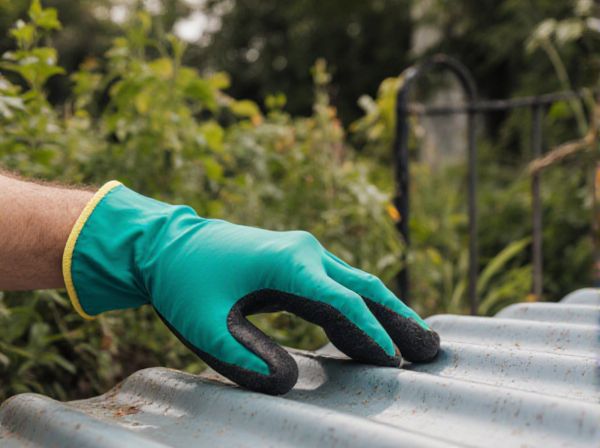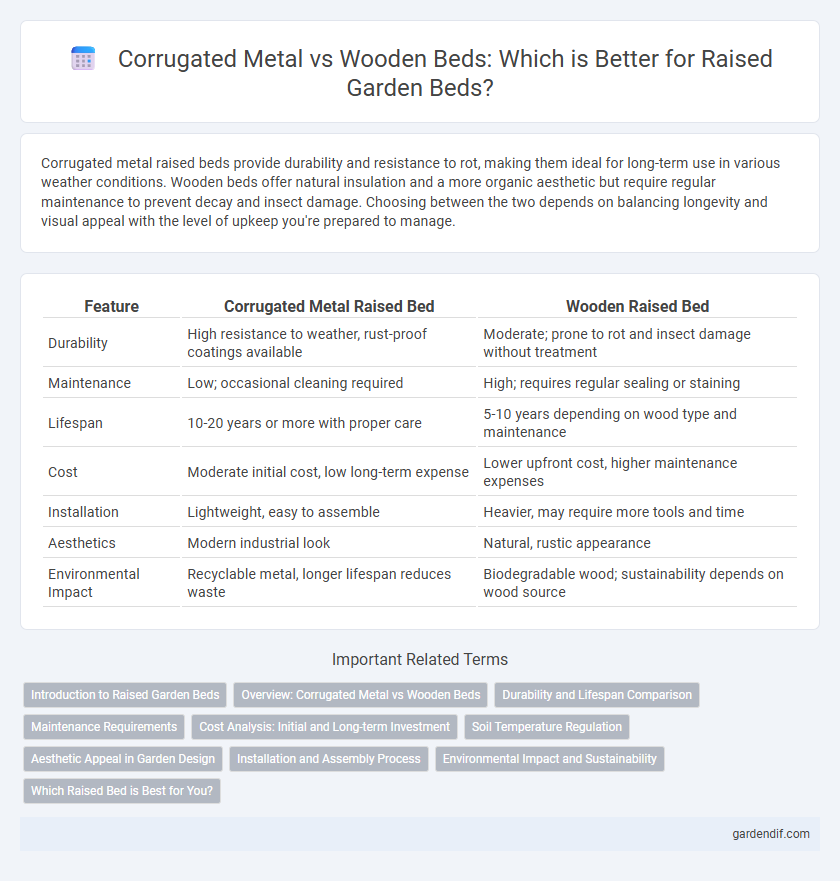
Corrugated metal bed vs Wooden bed Illustration
Corrugated metal raised beds provide durability and resistance to rot, making them ideal for long-term use in various weather conditions. Wooden beds offer natural insulation and a more organic aesthetic but require regular maintenance to prevent decay and insect damage. Choosing between the two depends on balancing longevity and visual appeal with the level of upkeep you're prepared to manage.
Table of Comparison
| Feature | Corrugated Metal Raised Bed | Wooden Raised Bed |
|---|---|---|
| Durability | High resistance to weather, rust-proof coatings available | Moderate; prone to rot and insect damage without treatment |
| Maintenance | Low; occasional cleaning required | High; requires regular sealing or staining |
| Lifespan | 10-20 years or more with proper care | 5-10 years depending on wood type and maintenance |
| Cost | Moderate initial cost, low long-term expense | Lower upfront cost, higher maintenance expenses |
| Installation | Lightweight, easy to assemble | Heavier, may require more tools and time |
| Aesthetics | Modern industrial look | Natural, rustic appearance |
| Environmental Impact | Recyclable metal, longer lifespan reduces waste | Biodegradable wood; sustainability depends on wood source |
Introduction to Raised Garden Beds
Raised garden beds made from corrugated metal offer durability, resistance to pests, and a modern aesthetic, making them ideal for long-term use in various climates. Wooden beds provide natural insulation, enhancing soil warmth and moisture retention while blending seamlessly into traditional garden settings. Both materials facilitate improved soil drainage and reduce soil compaction, optimizing plant growth and root development.
Overview: Corrugated Metal vs Wooden Beds
Corrugated metal raised beds offer superior durability and resistance to weather, making them ideal for long-lasting garden structures, while wooden beds provide a natural aesthetic and better insulation for soil temperature regulation. Metal beds are low-maintenance and less prone to pests and rot, whereas wooden beds may require periodic treatment to prevent decay and insect damage. Choosing between corrugated metal and wooden raised beds depends on priorities such as longevity, appearance, and environmental conditions.
Durability and Lifespan Comparison
Corrugated metal raised beds offer superior durability compared to wooden beds, resisting rot, pests, and weather damage, which extends their lifespan to 15-20 years or more. Wooden raised beds, while aesthetically pleasing and eco-friendly when made from cedar or redwood, typically last 5-10 years due to susceptibility to moisture and insect deterioration. For long-term investment in garden infrastructure, corrugated metal beds provide enhanced longevity and minimal maintenance requirements.
Maintenance Requirements
Corrugated metal raised beds require minimal maintenance due to their resistance to rot, pests, and weather damage, making them highly durable over time. Wooden raised beds, particularly untreated ones, demand regular upkeep such as staining, sealing, or replacing damaged boards to prevent decay and insect infestations. Metal beds also clean easily, whereas wood necessitates more care to maintain structural integrity and appearance.
Cost Analysis: Initial and Long-term Investment
Corrugated metal raised beds typically have a higher initial cost ranging from $50 to $150 but offer superior durability and low maintenance, extending their lifespan beyond 20 years. Wooden beds, especially those made from cedar or treated lumber, cost between $30 and $100 initially but require periodic sealing or replacement every 5 to 10 years, increasing long-term expenses. When analyzing cost efficiency, corrugated metal beds provide a better return on investment due to their resilience against rot, pests, and weather, reducing recurring costs compared to wooden alternatives.
Soil Temperature Regulation
Corrugated metal raised beds absorb and retain heat more efficiently, leading to higher soil temperatures that can benefit warm-season crops. Wooden beds offer better insulation, maintaining more stable soil temperatures and protecting roots from extreme heat fluctuations. Choosing between the two depends on the local climate and specific temperature needs of the plants grown.
Aesthetic Appeal in Garden Design
Corrugated metal raised beds offer a sleek, industrial aesthetic that complements modern or minimalist garden designs, providing a durable and weather-resistant option. Wooden raised beds deliver a warm, natural look that blends seamlessly with traditional or rustic garden styles, enhancing the organic feel of outdoor spaces. Choosing between corrugated metal and wood depends on the desired visual impact and how the material harmonizes with surrounding garden elements.
Installation and Assembly Process
Corrugated metal raised beds offer a straightforward installation process due to their lightweight panels and simple interlocking design, allowing for quick assembly with minimal tools. Wooden raised beds require more preparation, such as cutting lumber to size and securing boards with screws or nails, which can increase assembly time and complexity. Metal beds typically resist warping and rot, reducing maintenance, whereas wooden beds may need treatment and regular upkeep to maintain structural integrity.
Environmental Impact and Sustainability
Corrugated metal raised beds offer superior durability and recyclability, reducing waste and the need for frequent replacements, thus lowering their environmental footprint compared to wooden beds. Wooden raised beds, while biodegradable and sourced from renewable materials, often require chemical treatments to prevent rot, potentially leaching harmful substances into the soil. Choosing corrugated metal or sustainably harvested untreated wood with natural preservatives enhances long-term sustainability and minimizes ecological harm in garden setups.
Which Raised Bed is Best for You?
Corrugated metal raised beds offer durability, resistance to pests, and a modern aesthetic, making them ideal for gardeners seeking low maintenance and long-lasting structures. Wooden raised beds provide natural insulation, a classic appearance, and are easier to customize, but they may require more upkeep and are susceptible to rot and insect damage over time. Choosing the best raised bed depends on your climate, budget, and desired garden style, with metal suited for longevity and wood favored for versatility and natural appeal.
Corrugated metal bed vs Wooden bed Infographic

 gardendif.com
gardendif.com